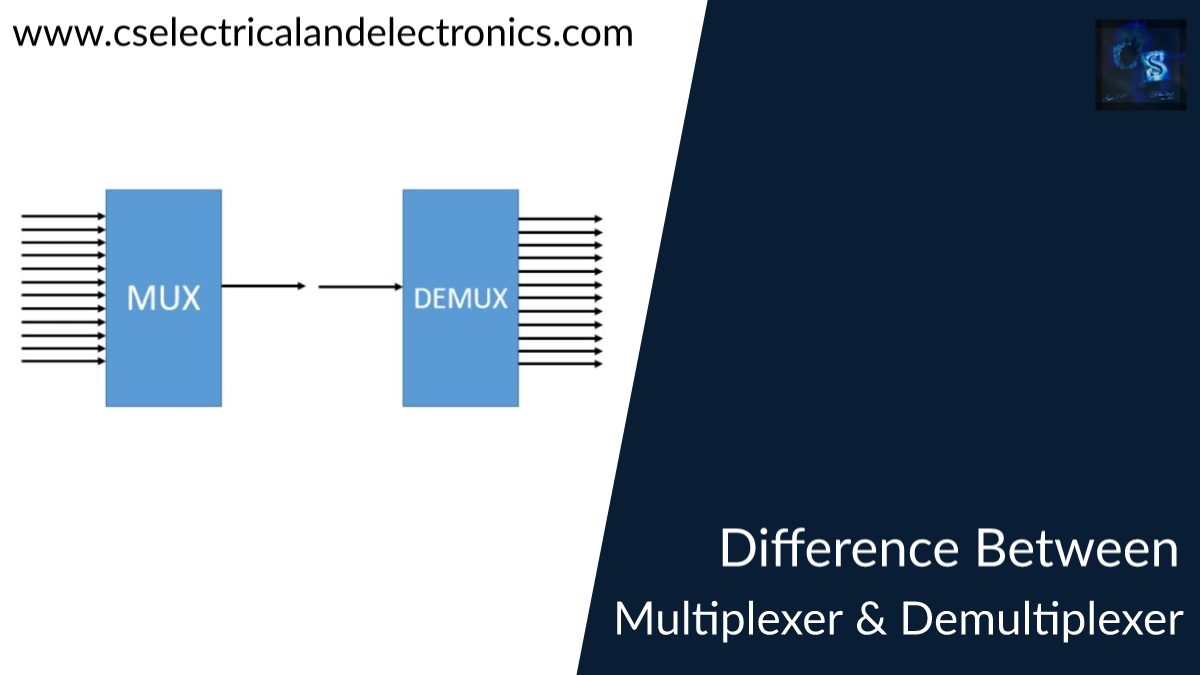Difference Between Multiplexers And Demultiplexers In Electronics
Hello guys, welcome back to our blog. In this article, we will discuss the difference between multiplexers and demultiplexers in electronics, what is a multiplexer, and what is demultiplexer.
If you have any electrical, electronics, and computer science doubts, then ask questions. You can also catch me on Instagram – CS Electrical & Electronics.
Also, read:
- BLDC Motor Control Methods, Best Controlling Method, Benefits
- Top 100 Electrical Companies In The World Where You Can Work
- Top 13 Websites For Research Papers For Engineers, MTech Students
Difference Between Multiplexer And Demultiplexer
Multiplexers and demultiplexers are the most common terminology in the field of network transmission. What are multiplexers and demultiplexers? Generally, there are three various techniques in multiplexing light signals onto a signal optical fiber link.
Those are optical time-division multiplexing (OTDM), code division multiplexing (CDM), and wavelength division multiplexing (WDM). Wavelength division multiplexing is the most common way of using wavelengths to increase bandwidth by multiplexing different optical carrier signals onto a single optical fiber.
This wavelength division multiplexing system is divided into two different wavelength patterns. One is coarse WDM and the other is dense WDM. CWDM provides a total of 18 channels across many transmission windows of silica fibers, while DWDM uses the c-band transmission window.
What is multiplexer
The multiplexer is a combinational circuit, which produces only one output but it can accept multiple data inputs. The term multiplexing is used in the communication and computer network field. Multiplexing is a process and technique of transmitting multiple analog or digital input signals or data streams over one channel. Multiplexing integrates multi-low-speed channels into one high-speed channel for transmission, the high-speed channel is effectively utilized.
By using multiplexing communication, carriers can avoid maintaining multiple lines, therefore operating costs are saved. A multiplexer is an electronic device, that performs the multiplexing process. This is a hardware component that combines multiple digital or analog input signals into a single line of transmission.
What is demultiplexer
The demultiplexer is a combinational circuit that accepts only one data input, but this input can be directed through multiple outputs. The demultiplexer is the reverse process of the multiplexer. This is a process of reconverting a signal containing digital or analog signal streams back to the original separate and unrelated signals.
The demultiplexer is just the reverse of the multiplexer, but it’s not the opposite of the multiplexer. The opposite of the multiplexer is called inverse multiplexing, which breaks one data stream into several related data streams. The difference between inverse multiplexing and demultiplexing is, the output streams of demultiplexing are unrelated, whereas the output streams of inverse multiplexing are related.
Difference between multiplexer and demultiplexer
01. A multiplexer is a combinational circuit, which produces only one output but it can accept multiple data inputs. Demultiplexing is a combinational circuit that accepts only one data input, but this input can be directed through multiple outputs.
02. Multiplexer performs parallel to serial conversion, whereas demultiplexer performs serial to parallel conversion.
03. Multiplexer increases the efficiency of the communication system by allowing the transmission of data like audio and video data transmission in the communication system. Whereas the demultiplexer receives the output signals from the multiplexer and converts them to their original form at the receiver end.
04. Within a computer memory, a multiplexer keeps a vast amount of memory in the computers and decreases the number of copper lines that are necessary to connect the memory to other parts of the computer as well. Whereas in arithmetic and logical unit, the output of this is given as input to the demux and then the output of the demux will be connected to multiple registers.
05. In the telephone network, the multiplexer integrates the multiple audio signals on a single line of transmission. Whereas in the serial to parallel converter, the converter is used to reform the parallel data. In this method, serial data will be given as an input to the demux and one counter will be attached to the demux to sense the data signal at the output of the demux. When all data signals are stored, the output of the demux can be read out in parallel.
06. Multiplexer will processes digital information from different sources into a single source. Whereas a demultiplexer will receive the digital information from a signal source and converts it into several sources.
07. Multiplexers can be also called data selectors whereas demultiplexers can be called data distributors.
08. Multiplexer is a digital switch whereas a demultiplexer is a digital circuit.
09. Multiplexer will follow the combination logical type and demultiplexer also follows the combinational logic type.
10. Multiplexer will be having an n data input, whereas demultiplexer is having only single data input.
11. Multiplexer is having single data outputs, whereas demultiplexer is having n data outputs.
12. Multiplexer works on a many-to-one operational principle, whereas the demultiplexer operates on a one-to-many operational principle.
This was about the “Difference Between Multiplexer And Demultiplexer“. I hope this article may help you all a lot. Thank you for reading.
Also, read:
- The Future Of Battery Management Systems In The Era Of Software Defined Vehicles
- Automotive-Grade Microcontrollers Vs General-Purpose MCUs: What Sets Them Apart?
- Upcoming Technologies To Learn In The Automotive Industry To Get High-Paying Jobs
- How Is DoIP Different From CAN-based Diagnostics?
- Difference Between Domain And Zonal Architecture in Automotive: A Complete Guide
- Roadmap To Become A Successful Hardware-in-the-Loop (HiL) Engineer
- 1000+ Automotive Interview Questions With Answers
- RTOS In The Automotive Industry: The Brains Behind Real-Time Vehicle Control
